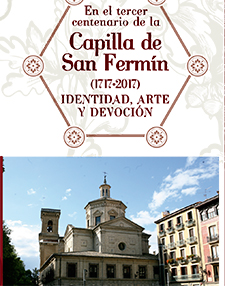On the third centenary of the
Chapel of San Fermín (1717-2017)
IDENTITY, ART AND DEVOTION
September 14, 2017
The cult of San Fermin in the funds and graphic collections of file Municipal de Pamplona
Ana Hueso Pérez. file Municipal of Pamplona
Defined as an external tribute of respect and love paid to the co-patron of Navarre, the cult of San Fermin is faithfully reflected in the documents integrated in the funds and collections that are kept in the file Municipal of Pamplona, product of the activity management assistant of several institutions, but with predominance of the municipal institution,
Documents, which are both means and messages of information and knowledge, have a triple dimension: the physical or material support, the informative message and the possibility of transmission or diffusion, a determining characteristic to establish the different documentary typologies, being the object of our attention a selection of graphic documents such as plans and drawings, from the eighteenth century, and iconographic documents such as photographs, abundant since the end of the nineteenth century.
From the textual documents it is known that the festive cult of the city of Pamplona to San Fermín goes back to the first century, although it will not be until the 12th century when a significant increase is noted, due to the bringing of the first relic from Amiens, by the Bishop of Pamplona Pedro de Artajona (1186), and the important rise of the Jacobean route, on account of the Franks who repopulated the cities of Navarre. The Diocesan Synod of 1301 already decrees the obligatory nature of keeping a feast on October 10, the day on which the Church of Amiens commemorated the entrance of the Saint in the city to convert it to the faith, and to celebrate its own Octave feast. It intensified in the 14th century, with the arrival of another new relic from Amiens (1386) that was placed in San Lorenzo, and the juries of the burghs agreed to celebrate the Saint's feast day as a feast. It is not until the 16th century that data appears in writing that determines the peculiar devotion to San Fermín. In the celebration of the Synod of Cesarini (1531) the feast of San Fermín appears in the degree scroll of Feriis, but still without canonical dedication as Patron Saint; in the Synod of Rojas Sandoval (1590), the date of celebration of the feast was changed to July 7; finally in 1599 the city of Pamplona professes its vow to him. The "patronal discord" over San Fermín and San Francisco Javier, which arose between the City Council of Pamplona and the Council of the Kingdom of Navarre in the 17th century, was resolved in the Concord established in 1646, The distribution of the festive celebrations was agreed upon in such a way that Pamplona would continue celebrating the feast of the Saint on July 7 and the Diputación would commemorate the invention of the relics, on January 13, in the church of San Lorenzo, and if both saints were to concur in the same procession, San Fermín would appear first, due to his double condition of Martyr and Bishop. Until 1657 it will not be settled definitively, when Pope Alexander VII declared San Fermín and San Francisco Javier as main Patrons of the Kingdom of Navarre, keeping the feast of obligation.
The first cartographic documents of the city of Pamplona, works of French geographers, depicting the silhouette of the newly built chapel of San Fermin (1717) are the only graphic documents corresponding to the first construction period of the same (1696-1717), the main place of worship and devotion to San Fermin.
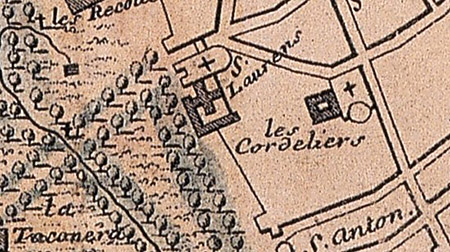
Map of Pamplona. 1719. Nicolás de Fer (Detail) /AMP
The graphic documents preserved illustrate the second construction period (1800-1805) and a curious project to erect a new building next to the garden of the Casa de Misericordia (then located on Paseo de Sarasate) between 1758 and 1860, which was not executed.

project for new chapel. Anonymous. 1759ca. /AMP
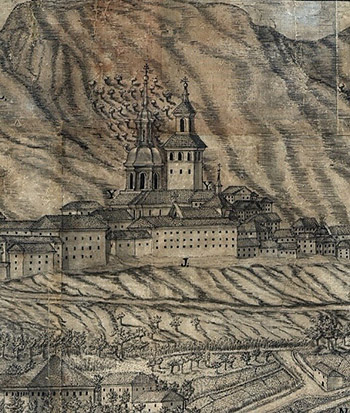
profile of the city of Pamplona. 1767. Ramírez de Arellano
Detail showing the tower of San Lorenzo and the lantern of the Chapel/AMP
The Diocese of Pamplona has traditionally honored San Fermín on four dates: January 13, the Feast of the Relics; July 7, the Saint's own feast; July 14, the Feast of the Octave; and September 25, the Feast of Martyrdom. Feast, Octave and Relics are celebrated in the Chapel (Parish of San Lorenzo); the Martyrdom in the Church of San Fermín de Aldapa and in San Lorenzo.
There is an abundance of photographic documents of the functions held in each of these festivals and places of worship, constituting unique evidence of their evolution over time.
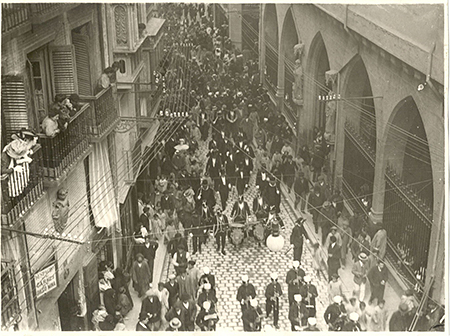
March to Vespers. 1908. Author unknown/AMP
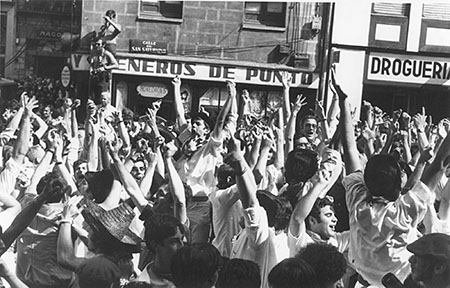
March to Vespers. 1971. Zubieta and Retegui/AMP.
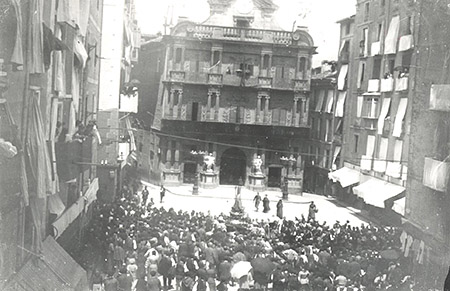
Procession of San Fermin. 1894. Author unknown/AMP
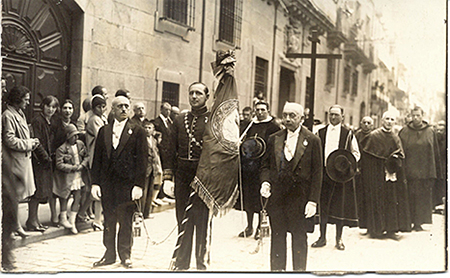
The flag of the city is carried by the councilman Mr. Enrique Ansaldo Bejarano, wearing the uniform of Gentilhombre de S.M. el Rey. The tassels were carried by Mr. Javier Ciga and Mr. Ignacio Altuve. 1930. Galle/AMP
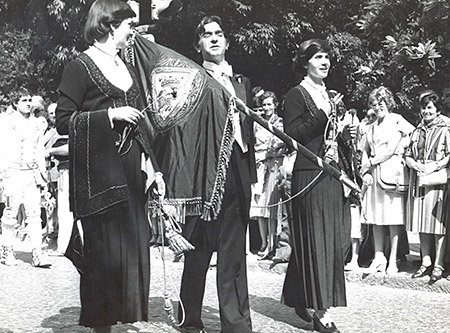
Incorporation of the councilwomen to the procession. 1979. Baigorri/AMP
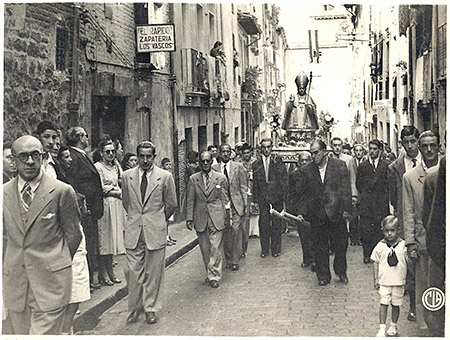
Feast of the Martyrdom of San Fermin. The procession in Mañueta Street. 1948. Company/AMP
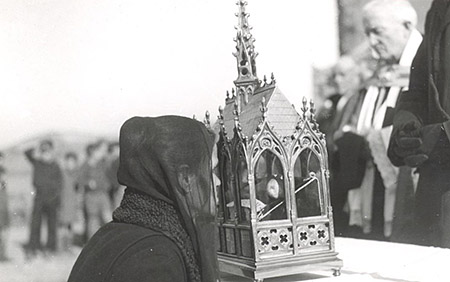
Arrival of a new relic. 1941. Galle/AMP
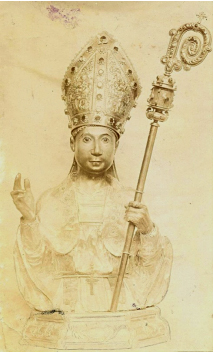
Bust-reliquary of San Fermin, work of 1527 that preserves the relic of 1186. Pamplona Cathedral. 1922. Gª Deán/AMP

chapel of the Town Hall. 1969. Galle/AMP

Church of San Fermín de Aldapa. 1890. Gª Deán/AMP

Church of San Fermín de los Navarros (Madrid). 1917. Gª Deán/AMP
PROGRAM
Tuesday, 12th September
The baroque construction of the chapel
José Luis Molins Mugueta. Chair of Heritage and Art in Navarre
The multiplied image of Pamplona and other representations of San Fermín in Navarre
Ricardo Fernández Gracia. Chair of Heritage and Art in Navarre
Wednesday, 13 September
The academic reform of the chapel
José Luis Molins Mugueta. Chair of Navarrese Art and Heritage.
protocol and ceremonial around San Fermín
Alejandro Aranda Ruiz. Chair of Navarrese Heritage and Art
Thursday, 14th September
The treasure of San Fermín: pieces of liturgy and devotion
Ignacio Miguéliz Valcarlos. Chair of Navarrese Heritage and Art
The cult of San Fermín in the graphic collections of file Municipal of Pamplona
Ana Hueso Pérez. file Municipal of Pamplona

